Forecast Enrollment Rate in Clinical Trials
Applied Clinical Trials
Building a structure for managing study operations through linking trial- and site-level forecasting.

On the surface, every veteran in clinical trials can tell you a lot about different factors impacting patient enrollment cycle times. A specifically defined patient population in a particular disease, for example, can impact the ability of sites to identify and recruit patients in a defined period of time, therefore, impacting enrollment cycle time. An experienced and successful investigator/site has better ability to enroll qualified patients compared to an inexperienced investigator/site. The higher proportion of experienced sites in a pool of sites deployed in a clinical trial can result in shorter enrollment cycle times.
Instinctively, when there are more investigators/sites being deployed for a trial with a defined number of patients needed, we should expect shortened enrollment cycle time. This sounds right, but is it really?
Here are two different scenarios:
- As clinical development organizations are under pressure to deliver new products faster, senior management seems happy to apply "unlimited" resources behind pivotal clinical trials evaluating promising drug candidates. The simple logic is to add more sites to the pool for enrollment, aiming to proportionately shorten enrollment cycle time. But realistically, how often does this shorten enrollment cycle time? The simple answer is: rarely, if at all.
- In another common scenario, when we are transitioning to a Phase III program after a successful Phase II program, we often "extrapolate" the operational results from Phase II trial(s) to Phase III trial(s); we use the enrollment rate from the Phase II trial(s) to calculate the number of sites needed for Phase III studies, hoping to achieve similar enrollment cycle times as we did in Phase II. That is all fine, except that the enrollment cycle time(s) will unlikely to be close to the calculation. The enrollment cycle times are generally substantially longer in this situation.
We have long noted that adding extra sites to a clinical trial has only limited impact to enrollment cycle time.1 We naturally want a better, in-depth understanding of the issue-is there a pattern between the number of sites deployed and enrollment cycle time? If the answer is yes, is it possible to define that pattern in a simple and universally applicable mathematical relationship?
Interestingly, similar phenomena exist in other areas. When we track the growth of a school of fish, we find the average size of the fishes grows rapidly in the earliest days since their hatch. The incremental increase of their size diminishes at the same time segment was added. Eventually, the average size of these fishes will hit a ceiling; they will no longer grow in size.
Similarly, when we charge a battery, we can relatively quickly get to, for example, the first 50% of the battery being charged. The charge speed slows down, until it hits a ceiling at some point.
We know that the fish growth pattern has been thoroughly studied by ecologists, and the pattern to charge a battery has also been thoroughly studied by physicists. Could we possibly borrow what they have learned and apply it to understand the relationship between investigator sites and enrollment rates?
We know it is never easy to find any pattern in clinical trial planning and execution, for a simple reason: each study is distinctly different, and there is no such thing as two identical trials.
This article is a part of the author's integrated effort to build a conceptual structure for managing study operations in clinical development by focusing on forecasting enrollment rate at the clinical trial level (clinical trial enrollment rate, CTER) and site level (gross site enrollment rate, GSER). We are able to establish a relationship between the site activation process and site enrollment performance.
This article will also establish the relationships between these concepts. They are truly integrated components of an increasingly comprehensive conceptual framework.
CTER (number of patients per trial per month)
Using a clinical development database created by the author-a sub-database-the following inclusion criteria was established:
- Interventional
- With 10 or more sites
- Started in year 2000 or later
- Completed enrollment at the time of analysis
And we excluded the following trials:
- Extension trial
- Registration trial
- Trials including healthy subjects
- Trials with expanded access
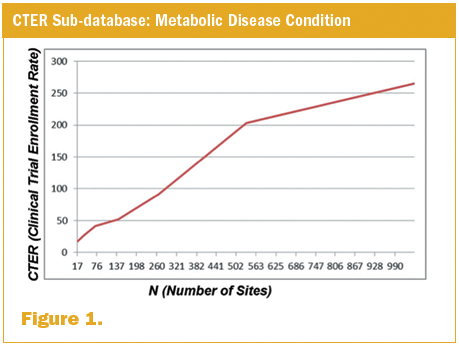
Figure 1.
The sub-database of relatively "homogeneous" clinical trials for a single metabolic disease condition is illustrated in Figure 1. We took the following steps to derive this chart:
- Focus on trials with a single disease condition as primary condition
- Put the clinical trial into baskets according to number of sites: 10 to 25 sites, 26 to 50, 51 to 100, 101 to 200, 201 to 400, 401 to 800, and 801 to more
- Build a data table to pair median number of sites and median of CTER (see Table 1).
- Plot the data pairs in a chart
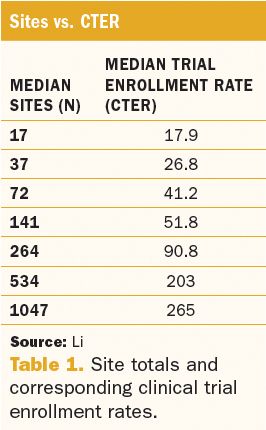
Table 1. Site totals and corresponding clinical trial enrollment rates.
Going through the same steps, we can draw similar charts for trials in a single respiratory and neurology disease condition, respectively (see Figures 2 and 3).

Figure 2
As a matter of fact, we can draw similar charts for a group of clinical trials in every single disease condition, when the sample size is big enough, and the disease condition is "pure" enough.
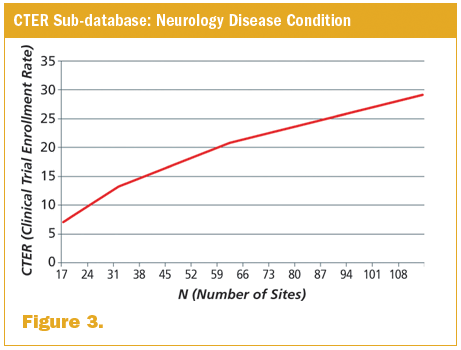
Figure 3
In each of the charts, we see a generalizable pattern: as more sites are added to a clinical trial in the same disease condition, the CTER increases. However, for every equal number of sites (N) added, the benefit to CTER diminishes. Eventually, the CTER will hit some sort of ceiling; the benefit from adding more sites becomes negligible.
The mathematics relationship is exactly the same relationship used to describe the growth rate for a school of fish in the ocean. Each of these charts seems to have distinct sizes and shapes. For the trained eyes of a mathematician, there is a simple equation to apply to the charts:
CTER = A * (1 - eBN) + C, where CTER1 = 363.7 * (1 - e-0.00124N) + 5.58. This equation is applied in Figures 4, 5, and 6.
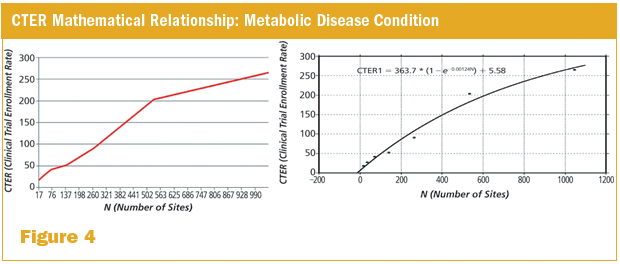
Figure 4
From what we know now, there is no "proportionate" relationship between number of sites and CTER. That is to say, the relationship between sites and enrollment rate are not linear. With all factors equal, adding sites to a clinical trial can increase CTER, but at a diminished incremental benefit. Moreover, the benefit diminishes as more and more sites are being added.
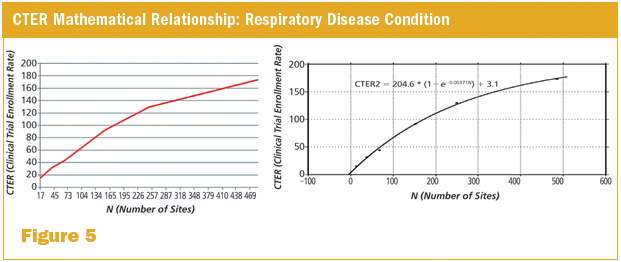
Figure 5
In another words, there is an operational boundary where we have to plan and execute clinical trials within. When we keep adding sites to a study, we will hit the ceiling at some point, where there will be no measurable benefit in gaining enrollment rate. It is safe to say that there is a limitation in terms of how far we can go to shorten enrollment cycle time by adding investigator sites.
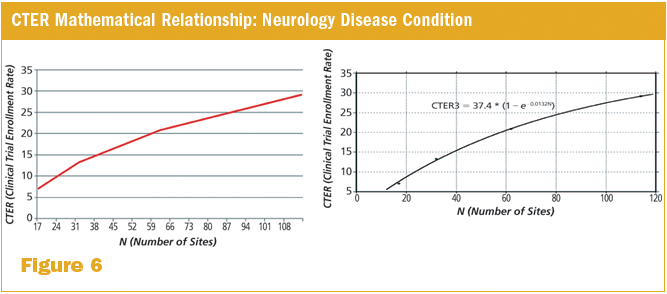
Figure 6
But why? If we were adding more sites to a trial relatively homogeneously, and assuming each of the sites behave in the same pattern as the others and do their job in recruiting patients for the trial, why can't their contributions be added up to give a "proportional" (linear) relationship to increase CTER?
GSER (number of patients per site per month)
The fact is, as we add more sites to a trial, participating sites can no longer behave in the same pattern as before. Simply put, the ability for individual sites to recruit and contribute patients is suppressed continuously as more sites are added to a clinical study, when other factors are equal.
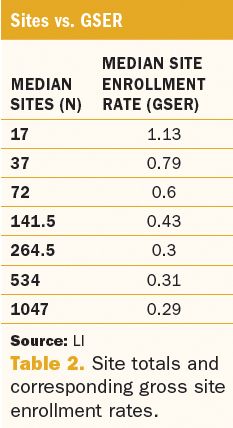
Table 2. Site totals and corresponding gross site enrollment rates.
Using the same approach illustrated to understand CTER, we can learn more about GSER. Starting from the same sub-database being used to understand CTER, we took the following step to build the chart showing the relationship between number of sites (N) and GSER:
- Focus on trials with a single disease condition as primary condition
- Put the clinical trial into baskets according to number of sites: 10 to 25 sites, 26 to 50, 51 to 100, 101 to 200, 201 to 400, 401 to 800, and 801 to more.
- Build a data table to pair median number of sites and median of GSER (see Table 2).
- Plot the data pair in a chart (see Figure 7).
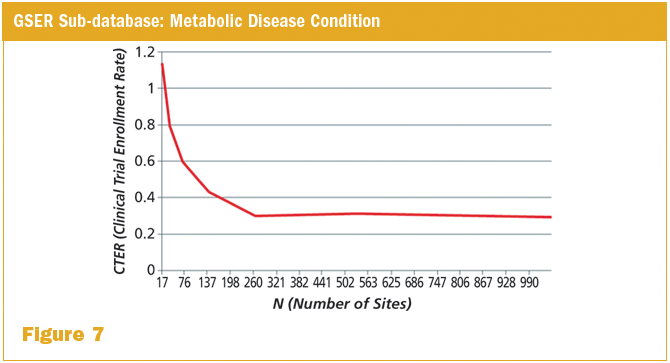
Figure 7
Going through the same steps, we can draw similar charts for trials in a single respiratory disease condition and trials in a single neurology disease condition (see Figure 8).
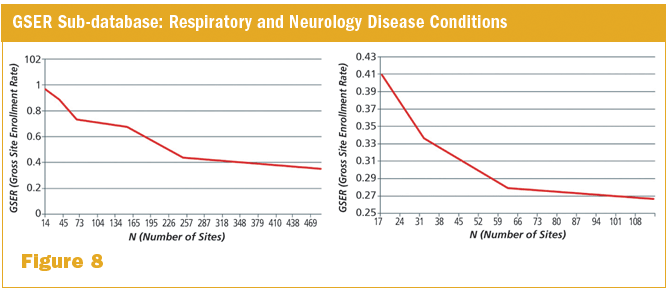
Figure 8
These charts have different sizes and shapes. But the pattern is relatively simple: as the number of sites used in a set of clinical trials for a single disease condition increases, GSER decreases. It is not a linear relationship. Rather, GSER drops much more quickly when the clinical trials involve a smaller number of sites. It stabilizes at a certain level when the clinical studies become big enough.
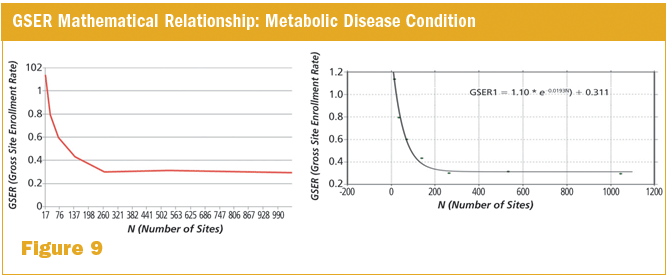
Figure 9
A shortcut is again used by utilizing the mathematical relationships behind this pattern:
GSER = a* eBN) + C, where GSER1 = 1.10 * e-1.93N) + 0.311. This equation is applied in the single metabolic, respiratory, and neurology disease condition trials in Figures 9, 10, and 11.
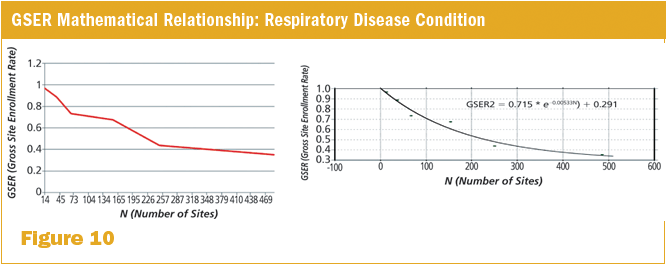
Figure 10
In the second scenario, as mentioned earlier, we cannot simply apply the site enrollment rate in a usually smaller Phase II clinical trial to a usually much larger Phase III trial. The GSER for a smaller Phase II study, when other factors are equal, is larger than the GSER for a larger Phase III trial. When we try to extrapolate the operational results from a Phase II clinical trial to a larger Phase III study, and use the GSER to predict the enrollment cycle time for the planned larger Phase III study, we end up with disappointing results. We will have longer enrollment cycle time, and often have to launch a "rescue mission."
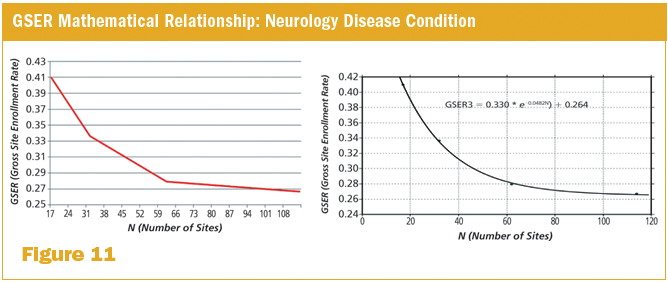
Figure 11
Discussion
As previously mentioned, there is no "proportionate" relationship between number of sites and CTER; the relationship between sites and enrollment rate are not linear. When other factors are equal, adding sites to a clinical trial can increase the trial-level enrollment rate, but at a diminished incremental benefit. Moreover, the benefit diminishes as an increasing number of sites are added.
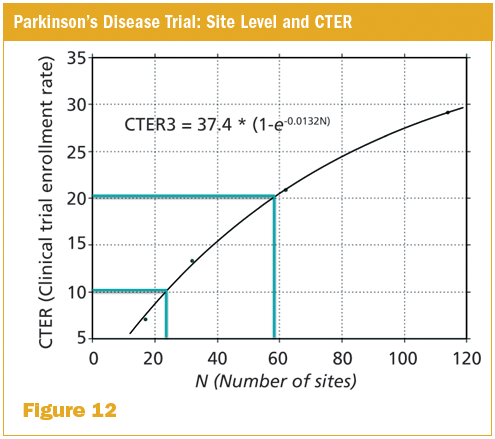
Figure 12
Let's use Parkinson disease clinical trials as an example. When we plug in CTER=10 patients per month in the chart, we get N=24. When we plug in CTER=20 patients per month in the chart, we get N=58 (see Figure 12). You can calculate the number of sites by plugging the CTER into the following equation without the aid of the chart:
CTER = 37.4 * (1 - e-0.0132N)
When other things are equal, if we want to double the trial enrollment rate, in order to shorten enrollment cycle time by half, we need to add more than twice as many sites to the pool (58 sites instead of 48). It is important to note that this is just an example to illustrate the concept. In reality, it is not usually possible to cut the enrollment cycle time by half.
This established relationship on CTER not only helps to understand the operational boundary, but also to quantitatively define the marginal benefit from adding investigator sites, which in return will help to optimize the planning and execution of clinical trials.

Figure 13
In a recent project to assess operational feasibility for an early-phase oncology study, the author was tasked to recommend operational parameters and to forecast operational deliverables. By depicting the relationship between number of patients and enrollment cycle time, it became obvious that 10 patients per site would help minimize enrollment cycle time (see Figure 13). For a 70-patient trial, we recommended that the team use seven sites. Using the method described in this article, we can establish the relationship between number of trial sites and GSER (see Figure 14).
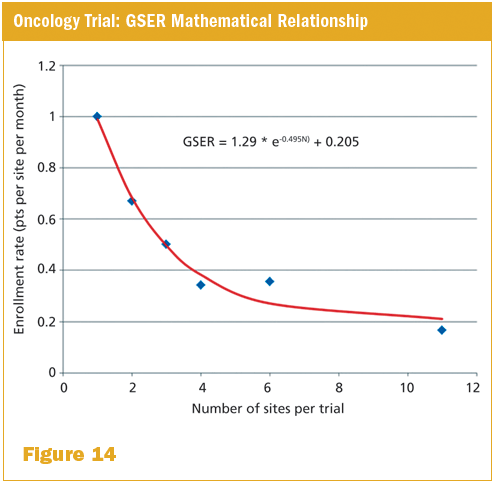
Figure 14
From the equation, we calculated the baseline enrollment rate (GSER) to be 0.2456 patients per site per month, and baseline enrollment cycle time to be calculated at 1,221 days. In our work, we continue to provide specific recommendations to improve the baseline enrollment cycle time through site enrollment performance improvement, business process improvement, site design optimization, etc. By using these approaches, it becomes feasible to shorten enrollment cycle time from 1,221 days at baseline to 705 days.
There are many factors that can be used to help us understand why larger trials have lower GSER than those of smaller trials. We established earlier that the enrollment performance for the pool of sites deployed in a clinical trial, as being measured by average site enrollment rate (ASER, number of patients per site per month), is impacted by the effectiveness of the site-activation process, which is measured by the site effectiveness index (SEI, 0% < SEI < 100%). With the introduction of GSER, we can use a simple formula to link all of them together:
GSER = ASER x SEI
As more sites (N) are involved in a clinical trial, operational complexity increases, which will lead to the decrease of SEI that, in return, will reduce the GSER.
There is another more simple reason. While it is always difficult to find high-performing investigator sites, it becomes more difficult when we need to identify an even larger number of sites. It is not surprising that the average enrollment performance for a trial with a larger number of sites will be lower than studies that use a smaller number of sites.
Over the years, our efforts to help and support our colleagues in planning and executing clinical trials have been focusing on the following two objectives:
- Level the playground for stakeholders in clinical trial planning and execution. By doing this, we can improve the effectiveness of communication among stakeholders, and objectively reward those colleagues that achieved quantifiable improvements.
- Provide actionable opportunities to improve operational deliverables through better site selection, better process, etc.
The establishment of a reliable way to forecast enrollment rate, both at the clinical trial level (CTER) and at the site level (GSER), will greatly enhance our ability to achieve our objectives. This is not to say that all clinical trials will and can fit in these equations perfectly. Quite the contrary; we know that most clinical studies will not be a perfect fit. But not only are we not discouraged by this fact, we claim that the "imperfect fit" is one of the most important value propositions of our method. We predict that the following factors will cause an "imperfect fit":
- A targeted age group too far away from "median" age group
- One or more biochemical and/or physiological and/or genetic measure(s) too far away from the "median" measures
- Targeted disease status too far away from a "regular" patient population
- Any other inclusion/exclusion criteria making the clinical trial too "unique"
While this is not an inclusive list, we are happy to say that our database is comprehensive enough to explain, often quantitatively, the impact from these factors.
Gen Li, PhD, MBA, is founder and president of PhESi, email: gen.li@phesi.com.
References
1. Gen Li, Lauri Sirabella, 2010. "Planning the Right Number of Investigative Sites for a Clinical Trial." The Monitor. 2010; 24(4): 54-58
2. Gen Li, 2009. "Finding the Sweet Spot." Pharmaceutical Executive. Oct. 2, 2009. Available at: http://pharmexe c.findpharma.com/pharmexec/R%26D/Finding-the-Sweet-Spot/ArticleStandard/Article/detail/631734 [2]
3. Gen Li, 2009. "Site Effectiveness Index and Methods to Measure and Improve Operational Effectiveness in Clinical Trial Execution." U.S. patent publication No. 2010-0250273
4. Robert Gray, Gen Li, 2011. "Performance-Based Site Selection Reduces Costs and Shortens Enrollment Time." The Monitor. 2011; 25(7): 32-36
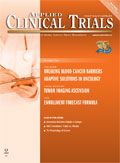
Improving Relationships and Diversifying the Site Selection Process
April 17th 2025In this episode of the Applied Clinical Trials Podcast, Liz Beatty, co-founder and chief strategy officer, Inato, discusses a number of topics around site engagement including community-based sites, the role of technology in improving site/sponsor relationships, how increased operational costs are impacting the industry, and more.
SCOPE Summit 2025: Enhancing the Patient Experience Through Site Centricity
February 12th 2025In an interview with ACT senior editor Andy Studna at SCOPE Summit, Ashley Davidson, vice president, product lead - sponsor tech strategy, Advarra, highlights the need for more site-centric approaches in study startup.